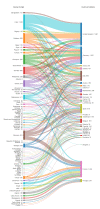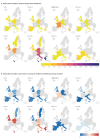Tuberculosis incidence in foreign-born people residing in European countries in 2020
- PMID: 37855907
- PMCID: PMC10588305
- DOI: 10.2807/1560-7917.ES.2023.28.42.2300051
Tuberculosis incidence in foreign-born people residing in European countries in 2020
Abstract
BackgroundEuropean-specific policies for tuberculosis (TB) elimination require identification of key populations that benefit from TB screening.AimWe aimed to identify groups of foreign-born individuals residing in European countries that benefit most from targeted TB prevention screening.MethodsThe Tuberculosis Network European Trials group collected, by cross-sectional survey, numbers of foreign-born TB patients residing in European Union (EU) countries, Iceland, Norway, Switzerland and the United Kingdom (UK) in 2020 from the 10 highest ranked countries of origin in terms of TB cases in each country of residence. Tuberculosis incidence rates (IRs) in countries of residence were compared with countries of origin.ResultsData on 9,116 foreign-born TB patients in 30 countries of residence were collected. Main countries of origin were Eritrea, India, Pakistan, Morocco, Romania and Somalia. Tuberculosis IRs were highest in patients of Eritrean and Somali origin in Greece and Malta (both > 1,000/100,000) and lowest among Ukrainian patients in Poland (3.6/100,000). They were mainly lower in countries of residence than countries of origin. However, IRs among Eritreans and Somalis in Greece and Malta were five times higher than in Eritrea and Somalia. Similarly, IRs among Eritreans in Germany, the Netherlands and the UK were four times higher than in Eritrea.ConclusionsCountry of origin TB IR is an insufficient indicator when targeting foreign-born populations for active case finding or TB prevention policies in the countries covered here. Elimination strategies should be informed by regularly collected country-specific data to address rapidly changing epidemiology and associated risks.
Keywords: TB; migrants; policy; prevention; refugees.
Conflict of interest statement
Figures




References
-
- Koch R. Die Aetiologie der Tuberkulose. [The etiology of tuberculosis]. Berl Klin Wschr. 1882;15:221-30. German.
-
- McAuliffe M, Triandafyllidou A. World Migration Report 2022. Geneva: International Organization for Migration (IOM); 2021. Available from: https://publications.iom.int/books/world-migration-report-2022
-
- European Centre for Disease Prevention and Control (ECDC), and World Health Organization Regional Office for Europe. Tuberculosis surveillance and monitoring in Europe 2022 – 2020 data. Copenhagen: WHO Regional Office for Europe and Stockholm: ECDC; 2022. Available from: https://www.ecdc.europa.eu/en/publications-data/tuberculosis-surveillanc...
-
- World Health Organization (WHO). Global Tuberculosis Report. Geneva: WHO; 2021. Available from: https://www.who.int/publications/i/item/9789240037021
MeSH terms
LinkOut - more resources
Full Text Sources
Medical
